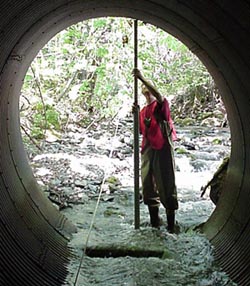Assessment of the Five Counties
 In an effort to determine the effect of County practices and policies on anadromous salmonids and their habitat, in 1998, the Five Counties Salmonid Conservation Program (5C) commissioned a thorough, objective evaluation. The University of California Cooperative Extension (UCCE) prepared an audit of the Five Counties. As a result, the following report was produced: In an effort to determine the effect of County practices and policies on anadromous salmonids and their habitat, in 1998, the Five Counties Salmonid Conservation Program (5C) commissioned a thorough, objective evaluation. The University of California Cooperative Extension (UCCE) prepared an audit of the Five Counties. As a result, the following report was produced:
“Effects of County Land Use Regulations and Management on Anadromous Salmonids and their Habitats: Humboldt, Del Norte, Mendocino, Siskiyou and Trinity Counties, California” PDF File (322 KB)
The Initial UCCE Report has guided the 5C Program Strategy. Many of the Program’s accomplishments and current activities were based on the findings and recommendations in this report.
Assessment Goals:
1. To determine the effectiveness of existing policies, regulations, California Environmental Quality Act (CEQA) process, mitigation measures, and land use practices in minimizing effects of county-regulated or funded activities on anadromous salmonids and their habitats.
2. To determine what, if any, additional procedures may be necessary to protect fish and habitats and where.
Assessment Area:
The assessment effort focused on two areas potentially affecting anadromous salmonid species: county facilities management and practices; and land use regulations and environmental review. Facilities management includes county roads, stream crossings, flood control channels, spoils disposal practices, and similar activities while land use regulation is focused on activities such as land divisions, use permits, rezoning, and CEQA review.
The review process used to develop the UCCE report was based on the biological needs of salmonid species. Non-biological considerations, such as private property takings or pre-existing conditions which would influence land use decisions were recognized but not necessarily considered in assessing impacts to salmonid habitat.
Recommendations:
 Based on the assessment’s findings, the following are examples of areas where the UCCE team made recommendations and to which the 5C Program has already begun to respond: Based on the assessment’s findings, the following are examples of areas where the UCCE team made recommendations and to which the 5C Program has already begun to respond:
- Road and bridge maintenance: Improvement of procedures and standardization of policies, with an emphasis on personnel training.
- Road inventory, taking into account sediment delivery.
- Adoption, improvement, and expansion of County policies and standards to provide better protection for riparian and in-stream habitat.
- Ongoing consultation with professional hydrologists and biologists on projects that potentially affect anadromous salmonids and their habitat.
- Ongoing workgroups and forums to facilitate information and technology exchange.
In 2008, about ten years after the 5C Program began, Phase I of the Re-Assessment of implemented Practices & Policies was completed. Findings from that re-assessment are included in:
“Policies and Procedures for Protecting Anadromous Salmonid Habitat in Del Norte, Humboldt, Mendocino, Trinity and Siskiyou Counties" PDF File (3.77 MB). Phase I Final Report on the Re-Assessment of County Land Use Regulations and Management, completed in 2008.
After that Phase I review of policies, Phase II, which focused on a field review of policy and practice implementation was completed in 2011. A report of Phase II work that provides a summary of findings, conclusions, and corresponding recommendations is available:
“Policies and Procedures for Protecting Anadromous Salmonid Habitat in Del Norte, Humboldt, Mendocino, Trinity and Siskiyou Counties. Field Assessment of Management Practices” PDF File ( 4066KB) Recommendations are based on observations made in the first and second phases of the reassessment.
Back to Programs Page
|
